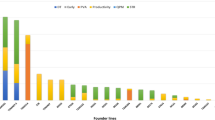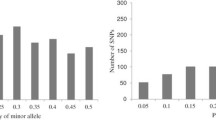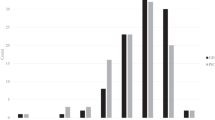Summary
In this study, 31 elite inbred lines of maize (Zea mays L.) were analyzed with 149 clone-enzyme combinations for their respective RFLP profiles. Objectives were (1) to determine the utility of RFLPs for estimation of genetic similarties among 16 inbred lines from the Iowa Stiff Stalk Synthetic (BSSS) and among 15 inbred lines from the Lancaster Sure Crop (LSC) heterotic groups and (2) to compare genetic similarities based on molecular markers with those based on pedigree information. Coefficients of genetic similarity (GS) and coancestry (f) between pairs of lines from the same heterotic group were calculated from RFLP and pedigree data, respectively. For lines from the BSSS heterotic group, cluster analyses based on RFLP and pedigree data revealed similar associations. GS and f values were closely correlated (r=0.70) for related BSSS lines. For lines from the LSC heterotic group, considerable discrepancies existed between the GS and f values, especially for those pairs involving inbreds Va22 and Lo924. Effect of selection and/or erroneous pedigree records are discussed as possible explanations for the low correlation of GS and f values (r=0.07) for related LSC lines. RFLPs seem useful for investigation of relationships among maize inbreds, verification of pedigree records, and quantification of the degree of relatedness.
Similar content being viewed by others
References
Adams, M.W. & J.W. Wiersma, 1978. An adaptation of principal components analysis to an assessment of genetic distance. Mich. State Univ. Agric. Exp. Stn. Res. Rep. 347.
Anonymous, 1989. Seedman's handbook. 16th ed. MBS Inc., Ames, Iowa.
Beckmann, J.S. & M. Soller, 1986. Restriction fragment length polymorphisms in plant genetic improvement. Oxford Survey of Plant Molecular and Cell Biology 3: 196–250.
Bertolini, M., M. Bosio, M. Bressan, F. Coppolino, N.Di Fonzo, E. Gentinetta, F. Introzzi, E. Lupotto, T. Maggiore, N. Perenzin, M. Snidaro, P. Valoti, A. Verderio, A. Bianchi, C. Soave, C. Lorenzoni, M. Motto & F. Salamini, 1991. Breeding activity of the maize station of Bergamo: synthetic gene pools and inbreds released in the period 1975–1989. Maydica 36: 87–106.
Burr, B., S.V. Evola, F.A. Burr & J.S. Beckmann, 1983. The application of restriction fragment length polymorphism to plant breeding. In: J.K. Setlow & A. Hollaender (Eds), Genetic engineering principles and methods, pp. 45–59, Vol. 5. Plenum Press, New York.
Burr, B., F.A. Burr, K.M. Thompson, M.C. Albertson & C.W. Stuber, 1988. Gene mapping with recombinant inbreds in maize. Genetics 118: 519–526.
Camussi, A., P.L. Spagnoletti Zeuli & P. Melchiorre, 1983. Numerical taxonomy of Italian maize populations: genetic distances on the basis of heterotic effects. Maydica 28: 411–422.
Cervantes, T.S., M.M. Goodman, E.E. Casas & J.O. Rawlings, 1978. Use of genetic effects and genotype by environmental interactions for the classification of Mexican races of maize. Genetics 90: 339–348.
Coe, E.H., M.G. Neuffer & D.A. Hoisington, 1988. The genetics of corn. In: G.F. Sprague & J.W. Dudley (Eds), Corn and corn improvement, pp. 81–258. 3rd ed. Agronomy Monograph. Am. Soc. Agron., Madison, WI.
Damerval, C., Y. Hebert & D. Devienne, 1987. Is the polymorphism of protein amounts related to phenotypic variability? A comparison of two-dimensional electrophoresis data with morphological traits in maize. Theor. Appl. Genet. 74: 194–202.
Darrah, L.L. & M.S. Zuber, 1986. 1985 United States Farm maize germplasm base and commercial breeding strategies. Crop Science 26: 1109–1113.
Dice, L.R., 1945. Measures of the amount of ecologic association between species. Ecology 26: 297–302.
Falconer, D.S., 1981. Introduction to quantitative genetics. 2nd Ed., Longman, London.
Helentjaris, T., G. King, M. Slocum, G. Siedenstrang & S. Wegman, 1985. Restriction fragment polymorphisms as probes for plant diversity and their development as tools for applied plant breeding. Plant Mol. Biol. 5: 109–118.
Helentjaris, T., 1987. A genetic linkage map for maize based on RFLPs. Trends Genet. 3: 217–221.
Henderson, C.B., 1984. Maize research and breeders manual. N. 10. Illinois Foundation Seeds Inc., Champaign, IL.
Lee, H., E.B. Godshalk, K.R. Lamkey & W.W. Woodman, 1989. Association of restriction fragment length polymorphism among maize inbreds with agronomic performance of their crosses. Crop Sci. 29: 1067–1071.
Livini, C., P. Ajmone Marsan, A.E. Melchinger, M.M. Messmer & M. Motto, 1992. Genetic diversity of maize inbred lines within and among heterotic groups revealed by RFLP. Theor. Appl. Genet. (in press).
Malecot, G., 1948. Les mathématiques de l'hérédité. Masson et Cies, Paris.
Melchinger, A.E., M.M. Messmer, M. Lee, W.L. Woodman & K.R. Lamkey, 1991. Diversity and relationships among U.S. maize inbreds revealed by restriction fragment length polymorphism. Crop Sci. 31: 669–678.
Murray, M., J. Cramer, Y. Ma, D. West, J. Romero-Severson, J. Pitas & S. Demars, 1988. Agrigenetics maize RFLP linkage map. Maize Gen. Coop. Newsletter 62: 89–91.
Nei, M. & W.H. Li, 1979. Mathematical model for studying genetic variation in terms of restriction endonucleases. Proc. Natl. Acad. Sci. USA 76: 5269–5273.
Nucca, R., C. Soave, M. Motto & F. Salamini, 1978. Taxonomic significance of the zein isoelectric focusing pattern. Maydica 23: 239–249.
Rohlf, F.J., 1989. NTSYS-PC Numerical taxonomy and multivariate analysis system. Version 1.50. New York Exeter Publishing Ltd.
Smith, J.S.C. & O.S. Smith, 1987. Associations among inbred lines of maize using electrophoretic, chromatographic and pedigree data. I. Multivariate and cluster analysis of data from Lancaster Sure Crop derived lines. Theor. Appl. Genet. 73: 654–664.
Smith, J.S.C. & O.S. Smith, 1987. Associations among inbred lines of maize using electrophoretic, chromatographic and pedigree data. I. Multivariate and cluster analysis of data from Iowa Stiff Stalk Synthetic derived lines. Theor. Appl. Genet. 76: 39–44.
Smith, O.S., J.S.C. Smith, S.L. Bowen, R.A. Tenborg & S.J. Wall, 1990. Similarities among a group of elite maize inbreds as measured by pedigree, F1 grain yield, grain yield heterosis and RFLPs. Theor. Appl. Genet. 80: 833–840.
Sprague, G.F., 1946. Early testing of inbred lines of corn. J. Am. Soc. Agron. 38: 108–117.
Stuber, C.W. & M.M. Goodman, 1983. Allozyme genotypes for popular and historically important inbred lines of corn. USDA-ARS Rep. Arrs. 16: 1–28.
Tanskley, S., 1983. Molecular markers in plant breeding. Plant Mol. Biol. Rep. 1: 3–8.
Wall, J.S., D.A. Fey & J.W. Paulis, 1984. Improved two-dimensional electrophoretic separation of zein proteins: application to study of zein inheritance in corn genotypes. Cereal Chem. 61: 141–146.
Walton, M. & T. Helentjaris, 1987. Application of restriction fragment length polymorphism (RFLP) technology to maize breeding. 42nd Annual Corn and Sorghum Research Conference, pp. 48–75.
Wilson, C.M., 1984. Isoelectric focusing of zein in agarose. Cereal Chem. 61: 198–200.
Wrigley, C.W. & K.W. Shepherd, 1977. Pedigree investigation using biochemical markers: the cultivar. Gabo Aust. J. Exp. Agric. Anim. Husb. 17: 1028–1031.
Author information
Authors and Affiliations
Rights and permissions
About this article
Cite this article
Ajmone-Marsan, P., Livini, C., Messmer, M.M. et al. Cluster analysis of RFLP data from related maize inbred lines of the BSSS and LSC heterotic groups and comparison with pedigree data. Euphytica 60, 139–148 (1992). https://doi.org/10.1007/BF00029669
Received:
Accepted:
Issue Date:
DOI: https://doi.org/10.1007/BF00029669




